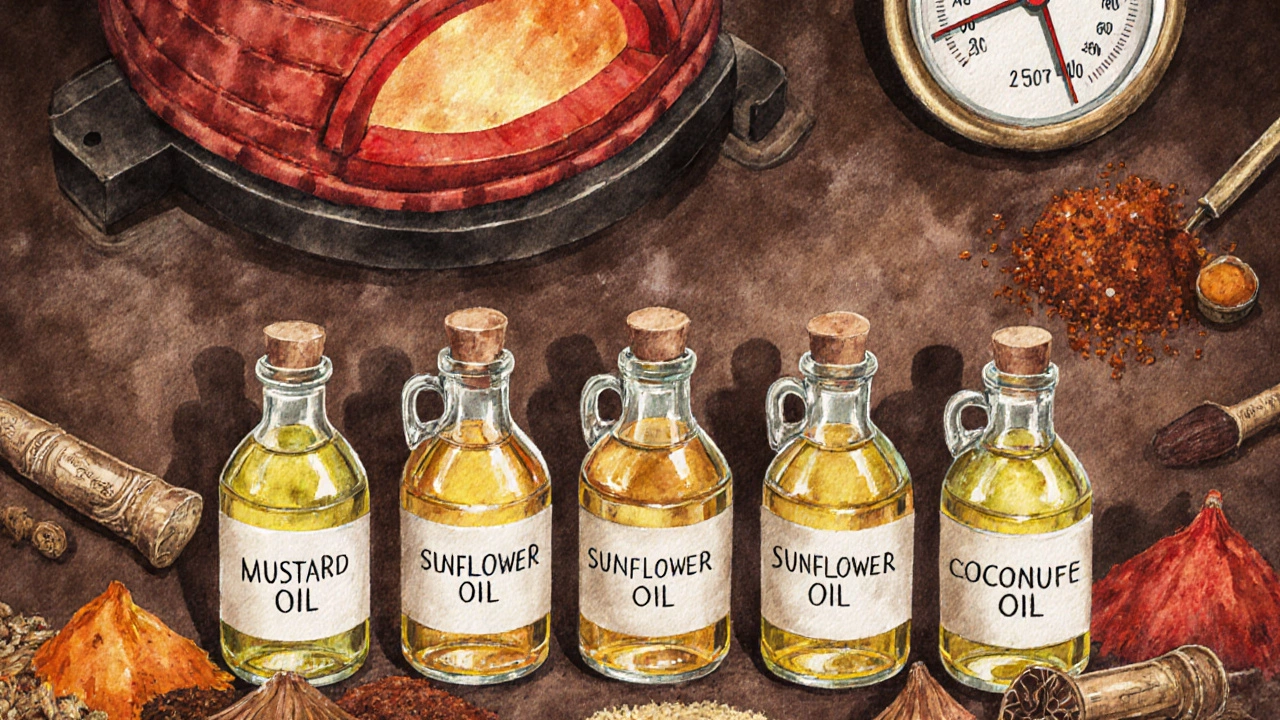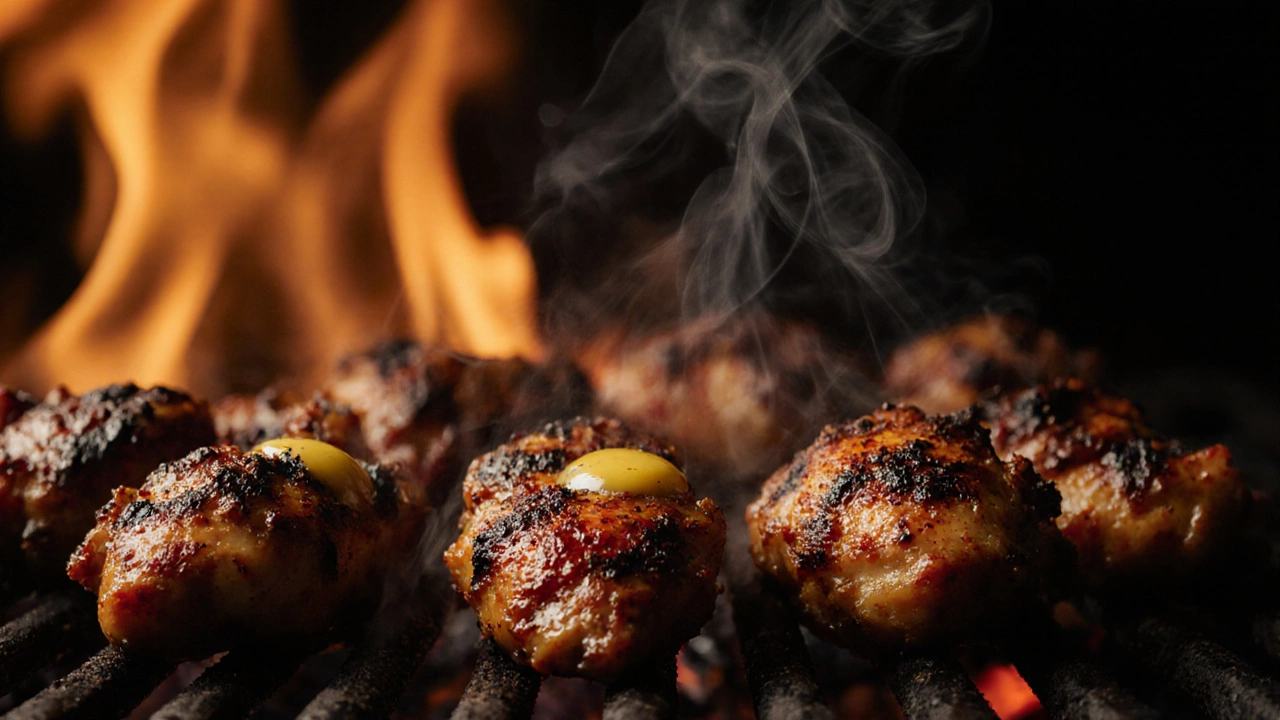Choosing the Best Oil for Tandoori Chicken: Flavor, Smoke Point & Health Guide
 Oct, 8 2025
Oct, 8 2025
Tandoori Chicken Oil Selector
Select your preferred criteria to find the best oil for your tandoori chicken recipe.
Recommended Oil for Tandoori Chicken
Oil Comparison Table
| Oil | Smoke Point | Flavor | Health Rating |
|---|---|---|---|
| Refined Mustard Oil | 250°C | Lightly nutty | Good |
| Ghee | 260°C | Rich buttery | Moderate |
| Sunflower Oil | 227°C | Neutral | Excellent |
| Canola Oil | 240°C | Very mild | Excellent |
| Coconut Oil | 177°C | Coconut sweetness | Mixed |
Key Takeaways
- High‑smoke‑point oils like refined mustard, sunflower or canola keep the chicken tender and prevent burnt flavours.
- For authentic aroma, a small amount of ghee or lightly smoked mustard oil works wonders.
- Balance health and taste: choose oils with a good omega‑3/omega‑6 ratio and minimal trans fats.
When you hear "tandoori chicken", you probably picture that smoky, reddish‑brown crust that makes the dish unforgettable. While the spice mix and charcoal fire get most of the credit, the oil you use in the marinade plays a silent yet decisive role. The right oil helps the spices cling, keeps the meat moist, and survives the intense heat of the tandoor or grill without turning bitter.
In this guide we’ll break down the science of oil, compare the most common choices, and give you a step‑by‑step plan for using the best oil for tandoori chicken in your kitchen.
Understanding How Oil Affects Tandoori Chicken
Tandoori chicken is a North‑Indian grilled dish where boneless or bone‑in chicken pieces are slathered in a yogurt‑spice blend and cooked at very high temperatures, traditionally in a clay tandoor oven. The oil in the marinade does three things:
- It creates a thin protective film that locks in moisture during the sear.
- It carries fat‑soluble flavor compounds from spices like cumin, coriander, and garam masala into the meat.
- It raises the overall smoke point of the mixture, preventing the yogurt from curdling or the spices from scorching.
Think of oil as the bridge between the acidic yogurt and the scorching heat. Without a proper bridge, the yogurt can separate, leaving the chicken dry and the grill covered in a bitter crust.

Criteria for Choosing the Right Oil
Every oil has a set of attributes that matter for tandoori cooking. Use the checklist below to score each option.
- Smoke point - the temperature at which oil starts to break down and produce smoke. Tandoors can reach 260‑300°C (500‑570°F), so aim for >250°C.
- Flavor profile - does the oil add a neutral canvas or a distinct taste? Neutral oils let the spice blend shine; aromatic oils add depth.
- Health rating - look for low saturated fat, high monounsaturated or polyunsaturated fats, and minimal trans fats.
- Availability & cost - consider what’s easy to find in your local market.
Top Oil Picks - Pros & Cons
Below is a quick comparison of the most popular oils for tandoori chicken. The numbers are based on data from food‑science labs and Indian culinary institutes as of 2025.
| Oil | Smoke Point (°C) | Flavor Impact | Health Rating | Recommended Use |
|---|---|---|---|---|
| Refined Mustard Oil A pungent oil popular in North‑Indian cooking, filtered to remove strong compounds. | 250 | Lightly nutty, subtle heat | Good - high monounsaturated fats, omega‑3 | Traditional tandoor; adds authentic aroma |
| Ghee Clarified butter with milk solids removed. | 260 | Rich buttery, caramel notes | Moderate - saturated fat but stable at high heat | Finishing drizzle; for extra richness |
| Sunflower Oil A neutral‑tasting oil extracted from sunflower seeds. | 227 | Neutral | Excellent - high vitaminE, low saturated | Budget‑friendly, works for most grills |
| Canola Oil Low‑er saturated, high omega‑3 oil from rapeseed. | 240 | Very mild | Excellent - low saturated, high monounsaturated | Best for home ovens or gas grills |
| Coconut Oil Oil from dried coconut meat, solid at room temperature. | 177 | Distinct coconut sweetness | Mixed - medium‑chain triglycerides, lower smoke point | Use sparingly for exotic flavor twists |
How to Use the Oil in Your Marinade
Follow these steps to incorporate the chosen oil without compromising texture.
- Measure 2‑3tablespoons of oil per pound of chicken. This ratio ensures a thin coating without making the mixture greasy.
- Whisk the oil into the yogurt‑spice blend until fully emulsified. If the oil separates, increase the yogurt proportion slightly.
- Add a pinch of salt and a dash of lemon juice - the acid helps the oil bind to the meat fibers.
- Coat the chicken pieces evenly. For bone‑in cuts, massage the mixture into crevices.
- Marinate for at least 4hours, preferably overnight. The oil slows moisture loss during the high‑heat sear.
- When ready to cook, pre‑heat the tandoor or grill to 260°C. Lightly oil the grill grates with the same oil to prevent sticking.
Pro tip: If you’re using a home oven, set the broiler to its highest setting and place the chicken on a rack over a tray. Brush a thin layer of oil on top just before the first 5minutes; this mimics the tandoor’s sear.

Health Considerations
Many home cooks worry that high‑temperature cooking destroys nutrients. In reality, the primary concern is the formation of harmful aldehydes when oils exceed their smoke point. Choosing an oil with a suitable smoke point eliminates that risk.
Here’s a quick health snapshot:
- Refined mustard oil offers a favorable omega‑3 to omega‑6 ratio (1:4) and contains allyl isothiocyanate, which has mild anti‑inflammatory properties.
- Ghee is rich in conjugated linoleic acid (CLA) that may support metabolism, but keep portions modest due to saturated fat.
- Sunflower and canola oils are low in saturated fat and high in vitaminE, making them heart‑friendly choices for frequent use.
- Coconut oil provides medium‑chain triglycerides (MCTs) that are quickly metabolized, yet its low smoke point means it should be used only for short‑duration cooking or added after grilling.
Overall, a blend of 70% high‑smoke‑point neutral oil (like canola) and 30% aromatic oil (like mustard) gives you both health benefits and authentic flavor.
Common Mistakes and How to Avoid Them
Even seasoned cooks slip up. Spot the pitfalls before they ruin your tandoori batch.
- Using extra‑virgin olive oil. Its smoke point (≈190°C) is far too low for a tandoor, leading to bitter notes.
- Over‑marinating with too much oil. The coating becomes slick, causing flare‑ups and uneven browning.
- Skipping the oil altogether. Yogurt alone can dry out the meat, especially near the bone.
- Re‑using oil between batches. Residual burnt particles lower the effective smoke point and add off‑flavours.
Stick to fresh oil, measured quantities, and the recommended smoke‑point range, and your tandoori chicken will stay juicy, aromatic, and safe.
Frequently Asked Questions
Can I use regular mustard oil instead of refined?
Regular (unrefined) mustard oil has a much lower smoke point (≈160°C) and a strong pungency that can overwhelm the spice blend. For tandoori, always choose refined mustard oil or filter the raw oil to remove the bitter compounds.
Is it okay to mix two oils together?
Yes. A 70/30 mix of a neutral high‑smoke‑point oil (like canola) with a flavorful oil (like refined mustard) gives you the best of both worlds-stable cooking performance and authentic taste.
What if I don’t have a tandoor at home?
A charcoal grill or a very hot oven broiler works fine. Pre‑heat to the highest setting, place the marinated chicken on a wire rack, and brush a thin layer of oil on top during the first few minutes to simulate the tandoor’s sear.
How long should the chicken stay in the oil‑yogurt mix?
At least 4hours, but overnight (8‑12hours) yields deeper penetration of flavors and a more tender texture. In a rush, 2hours is the minimum.
Is ghee better than oil for health?
Ghee provides a rich mouthfeel and is stable at high heat, but it contains more saturated fat than most plant oils. Use it sparingly-perhaps a drizzle after grilling-to enjoy the flavor without overdoing the saturated fat.
Pick the oil that matches your taste, budget, and health goals, and you’ll consistently nail that iconic tandoori char. Happy grilling!
